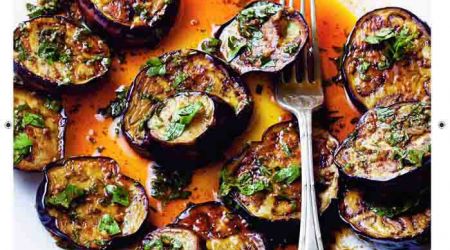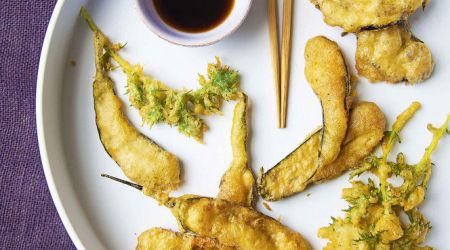Aubergines
Coming from the East, they are a sponge for flavour and soak up spices as well as oil. Striped or purple, bulbous or slender, the 'eggplant' is cracking, says Clarissa Hyman with recipes by Linda Tubby
Imam bayildi is one of the most famous Middle Eastern dishes that is made with aubergines. The name means ‘the imam fainted’, supposedly because the good gentleman passed out on learning of the amount of expensive oil it contained. Lesser-known variations include imam aggro (‘the imam became rather annoyed’), imam chunder (‘the imam was very sick’) and imam kickass (‘the imam cut off the head of the cook’). Just joking, of course, but the affinity of oil for aubergine is a serious relationship, a transformative partnership that brings the best out of this beautiful, glossy, purple vegetable. In the best traditions of two nations separated by a common language, the aubergine is called an eggplant in the American-English-speaking world. Which is perhaps why we should all talk in Latin, and instead refer to this fascinating vegetable as Solanum melongena. While a member of the potato/tomato family, and indeed the nightshade clan, aubergines were not in fact discovered in the New World by Columbus.
They are thought to have originally grown wild in India before spreading throughout South-East Asia – the first record of cultivation coming from China in a 5th-century BC work on agriculture. They only travelled towards Mediterranean Europe with the Moors thousands of years later. The word ‘aubergine’ itself even reflects the journey from the original Sanskrit through Arabic to Catalan and finally French. In Asia and the Middle East, aubergines remain hugely popular and a fundamental part of the cuisine. Colin Spencer speculates this is linked to the way the mild, spongy aubergine flesh willingly soaks up added flavours, especially spices, in a whole range of Indian cooking. It was popular initially in Sicily and southern Italy but less so further north on the peninsula where they were considered unhealthy. The food writer Anna Del Conte notes that a 14th-century writer regarded them as ‘causing males to swerve from decent behaviour’. When it turned up in England, herbalist John Gerard in 1597 advised caution, writing ‘doubtless these apples have a mischievous quality; the use thereof is utterly forsaken’. In France, it was rumoured that they provoked fever and epilepsy, at least until the late 18th century when they became all the rage among the ‘Incroyables’ and the ‘Merveilleuses’, the social trendsetters of the day. In India and America, it is common to find white or creamy aubergines roughly the size of an egg – providing a simple explanation for how the name ‘eggplant’ came about.
There are, in fact, many varieties beside the familiar purple truncheon, including lilac, mauve, striped green and white, and mini green ones the size of marbles. They may be round, oval, elongated like clubs or the shape of teardrops. They need warmth to grow: in temperate climates, this usually has to be done under glass, although they can fruit outside until the end of October. The difference between the varieties is one of personal choice and culinary destiny more than flavour. Violetta are handsome and fat; Moneymaker are early-ripening; Black Enorma can grow to monstrous size; Easter Egg looks like a small hen’s egg; Slim Jim are small, tomato-sized; Rosa Bianca is a bulbous white and pink with luxuriant flesh. Not only must aubergines be cooked, but they are also one of the few vegetables to thereby radically change their flavour, texture and appearance. On purchase, they should look firm and lustrous. You can also tell if they are ripe by looking under the calyx – if the skin is pure white, the fruit is ripe but if tinged green, wait a few days, as they will ripen on and off the plant. When old they get soft and dull, and the calyx turns dry and brown. To salt or not to salt the raw vegetable before cooking is a debate that continues, although many modern cultivars have been bred to eliminate their natural bitterness. On the other hand, salting, as authorities such as the culinary scientist Harold McGee explains, helps counteract the tendency of aubergines to take up great quantities of oil. One way to get rid of their ‘intercellular air pockets’, he suggests, is to slice, salt, rinse and pat dry before frying or grilling. For a purée, whole aubergines can be pricked and baked before slicing and scooping out the soft flesh, or else the aubergine can be boiled or steamed.
In theory, this is supposed to reduce the oil absorption rate, but it doesn’t always work in practice, I have to say. Aubergine recipes are legion: stuffed, baked in moussaka, with meatballs, in salads, dips, pickles and meat and vegetable stews from ratatouille to caponata. They have a natural affinity with garlic, tomatoes, courgettes, onions, lemons, basil and cheese. The Syrians and Turks claim to know a thousand ways in which to prepare aubergines, and the Italian connection has brought many dishes into the repertoire such as pasta alla Norma and melanzane parmigiana. Scorched over an open flame until the skin crackles, chars and flakes away, the flesh acquires a wonderful smoky flavour for dips and purées. You probably won’t faint like the proverbial imam, but you may just come close.
.jpg)
Recipes
Get Premium access to all the latest content online
Subscribe and view full print editions online... Subscribe



